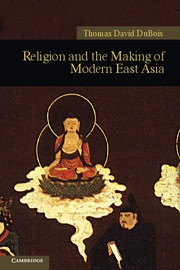Book contents
- Frontmatter
- Contents
- List of Boxes, Figures, and Maps
- Preface
- 1 In the beginning: Religion and history
- 2 Ming China: The fourteenth century's new world order
- 3 The Buddha and the shōgun in sixteenth-century Japan
- 4 Opportunities lost: The failure of Christianity, 1550–1750
- 5 Buddhism: Incarnations and reincarnations
- 6 Apocalypse now
- 7 Out of the twilight: Religion and the late nineteenth century
- 8 Into the abyss: Religion and the road to disaster during the early twentieth century
- 9 Brave new world: Religion in the reinvention of postwar Asia
- 10 The globalization of Asian religion
- Glossary
- Timeline of dynasties and major events
- Suggestions for further reading
- Index
3 - The Buddha and the shōgun in sixteenth-century Japan
Published online by Cambridge University Press: 05 June 2012
- Frontmatter
- Contents
- List of Boxes, Figures, and Maps
- Preface
- 1 In the beginning: Religion and history
- 2 Ming China: The fourteenth century's new world order
- 3 The Buddha and the shōgun in sixteenth-century Japan
- 4 Opportunities lost: The failure of Christianity, 1550–1750
- 5 Buddhism: Incarnations and reincarnations
- 6 Apocalypse now
- 7 Out of the twilight: Religion and the late nineteenth century
- 8 Into the abyss: Religion and the road to disaster during the early twentieth century
- 9 Brave new world: Religion in the reinvention of postwar Asia
- 10 The globalization of Asian religion
- Glossary
- Timeline of dynasties and major events
- Suggestions for further reading
- Index
Summary
Religious foundations of medieval Japan
As we leave China and move to Japan, it is worth considering some of the reasons why these two close neighbors are so very different.
The best place to begin is by looking at a map. China is a massive piece of territory: the geographic anchor of East Asia. With Taiwan included, China is slightly larger than the United States. The Ming Empire was significantly smaller – just over half the size of the People's Republic of China today – but that is still roughly as large as the entire European Union. It was also exceedingly diverse. Even after the expulsion of the Mongols, Ming dynasty China was still home to a large variety of non-Han peoples. It was also surrounded by all the cultures of Asia: the Indic-influenced kingdoms of mainland Southeast Asia, Buddhist kingdoms in Tibet and modern Mongolia, Central Asian Muslims who traded along the Silk Road, and Chinese-style polities in Korea and Manchuria. Chinese call their country the Middle Kingdom, and for centuries, it very much was the great cultural behemoth that sat squarely at the crossroads of the world.
Japan, in contrast, is an island (or more precisely, an archipelago). In size, Japan is about as large as the state of California, but before the large northern island of Hokkaido was fully incorporated in the late nineteenth century, it was roughly the size of Italy or the Philippines.
- Type
- Chapter
- Information
- Religion and the Making of Modern East Asia , pp. 53 - 71Publisher: Cambridge University PressPrint publication year: 2011



